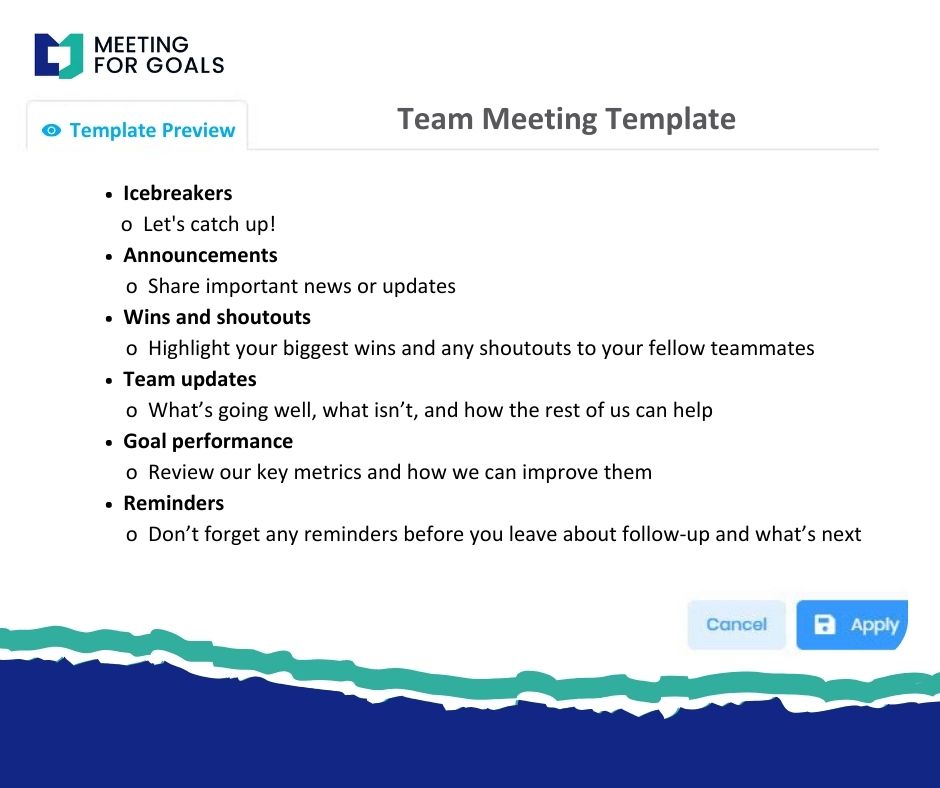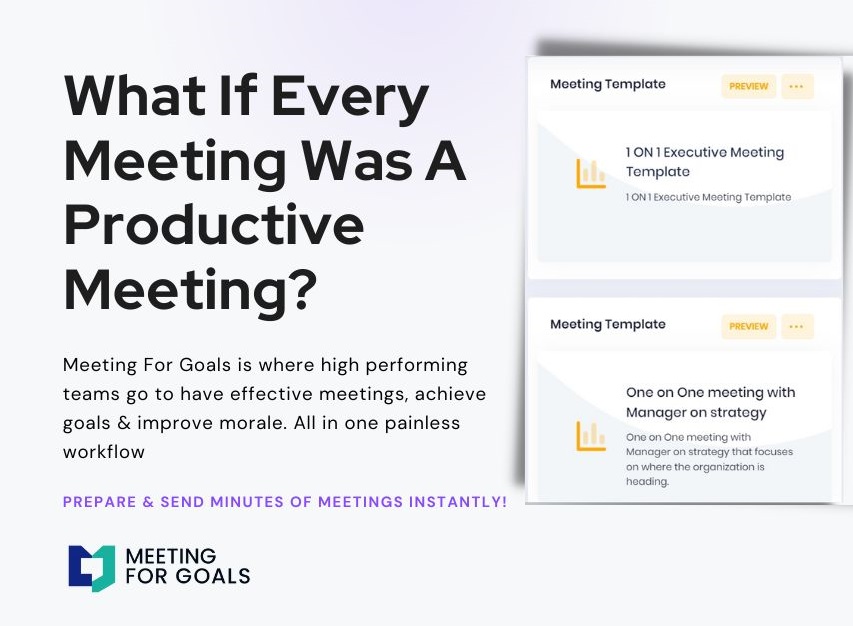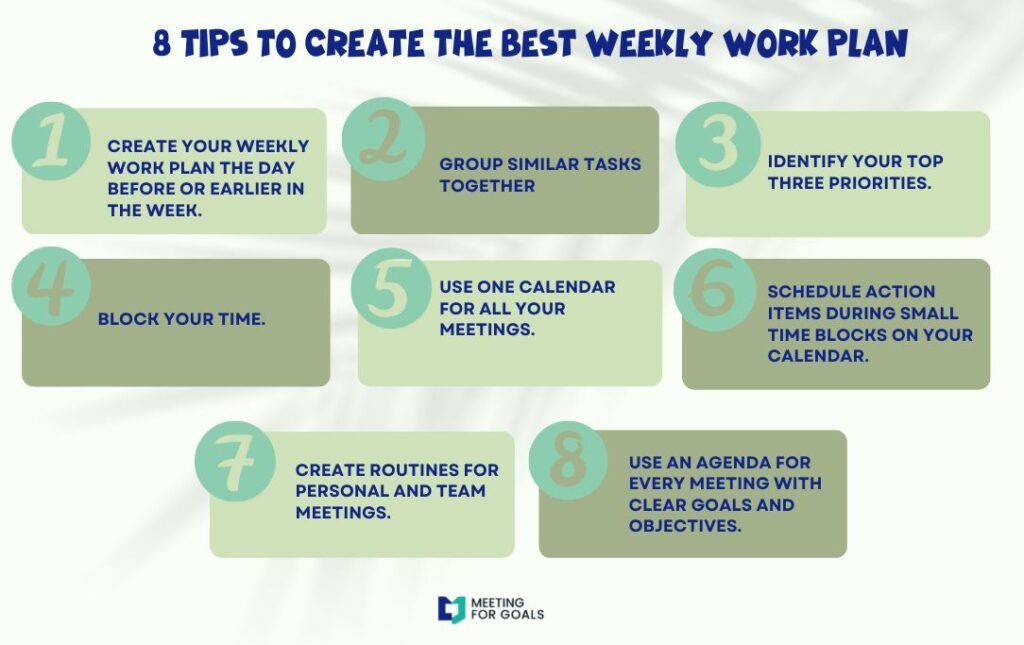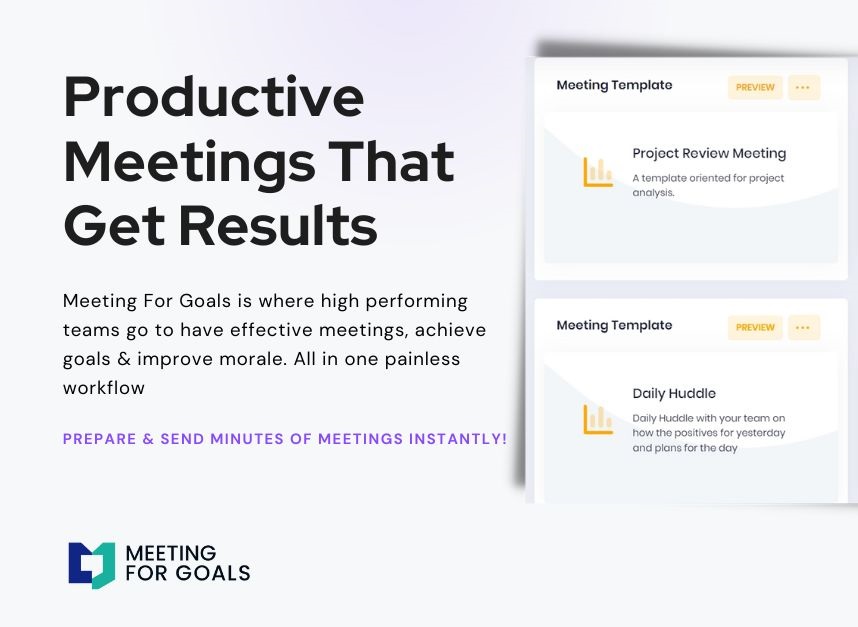The Ultimate Guide to One-on-One Meeting Questions for High-Performing Teams
Introduction
One-on-one meetings can be one of the most powerful tools in your leadership toolkit—if you use them right. For growing companies with 40–70 employees, these meetings are more than just a recurring calendar event. They’re your chance to build trust, align goals, and keep your team on track.
But here’s the thing: Not all one-on-ones are created equal. A productive session can energize your team and move the needle. A poorly run one? It’s just a half-hour of lost time.
At Meeting For Goals, we help leaders turn one-on-ones into strategic conversations. Our platform streamlines the entire meeting process—from agenda planning to tracking progress—so you can focus on what matters most: your people.
In this guide, we’ll walk you through the most effective one-on-one meeting questions to build alignment, accountability, and engagement. Whether you’re a team lead, director, or C-suite executive, these insights will help you lead more meaningful conversations.
Ready to level up your one-on-ones? Let’s dive in.
Want to save time and run better meetings? Try our free meeting templates at https://meetingforgoals.com/meeting_templates or sign up now at https://app.meetingforgoals.com/TenantRegistration/Register
2 Minute Video
Watch a 2 minute demo of our meeting management software in action
Section 1: The Purpose of One-on-One Meetings
One-on-one meetings aren’t just about status updates. They’re about connection, clarity, and continuous improvement.
At their core, these meetings are private conversations between a manager and a team member. Unlike group meetings, one-on-ones create space for honest feedback, personal check-ins, and forward-looking planning.
For companies in the 40–70 employee range, this is especially important. You’re growing fast. Roles are expanding. And if you’re not careful, misalignment can creep in. One-on-ones help keep everyone rowing in the same direction.
Here’s what great one-on-ones achieve:
Team Alignment
When managers reinforce goals and priorities during these meetings, employees stay focused. Clear direction reduces confusion and helps people make better day-to-day decisions.
Real-Time Feedback
One-on-ones are the perfect place to give and receive feedback. You can catch small issues before they become big problems—and celebrate wins as they happen.
Stronger Relationships
Trust is the foundation of any high-performing team. Regular one-on-ones show your team you care, which makes it easier to have tough conversations when needed.
Employee Engagement
According to Gallup, employees who have regular meetings with their managers are three times more likely to be engaged at work. These meetings show people that their voice matters.
Meeting For Goals helps you structure these conversations with customizable templates and built-in goal tracking. That means every one-on-one is tied to your company’s bigger picture.
When you understand the purpose of these meetings, everything else falls into place. You’ll ask better questions, have more meaningful conversations, and create real momentum.
Adding an Agenda
How to add an agenda instantly on Meeting For Goals
Section 2: Key Questions to Open the Dialogue
The first few minutes of a one-on-one set the tone. If you jump straight into tasks, you might miss what’s really going on with your team member.
That’s why it’s important to start with questions that build trust and open the door to honest conversation.
Try these openers:
- “How are you feeling about work this week?”
- “What’s something that’s gone really well recently?”
- “Is there anything on your mind that we haven’t talked about yet?”
- “What’s something you’re excited about right now?”
- “How’s your energy level lately?”
These aren’t throwaway questions. They help you understand your team’s emotional state, spot early signs of burnout, and uncover hidden wins.
Psychological safety is key here. When people feel safe, they’re more likely to speak up—and that’s when you get the insights that really matter.
At Meeting For Goals, you can build these questions into your meeting templates. That way, every conversation starts with empathy and intention. Plus, you can track responses over time to spot patterns and trends.
For leaders managing multiple teams, these opening questions also give you a pulse on organizational health. Are people feeling energized? Overwhelmed? Disconnected? These insights can guide broader decisions.
Remember, the goal at this stage isn’t to solve problems. It’s to connect. And connection is the foundation of every great team.
Want to see how structured meeting templates can make your life easier? Explore them here: https://meetingforgoals.com/meeting_templates
Section 3: Performance and Progress Questions
Once you’ve built rapport, it’s time to talk about performance. This is where your one-on-one becomes a tool for accountability and growth.
The right questions help you understand what your team member is working on, what’s going well, and where they might need support.
Here are some examples:
- “What’s something you’ve accomplished since our last meeting?”
- “What’s been the biggest challenge you’ve faced recently?”
- “Is anything blocking your progress right now?”
- “Do you feel like your work is aligned with your strengths?”
- “What would help you be more effective?”
These questions encourage reflection and self-awareness. They also give you a chance to provide coaching, remove roadblocks, and recognize achievements.
For growing companies, alignment is everything. If people are working hard on the wrong things, you lose time and momentum. That’s why Meeting For Goals integrates goal tracking directly into your meeting workflow. You can see how individual tasks tie into team and company goals—no guesswork required.
Another benefit? These conversations reduce the need for micromanagement. When your team knows they’ll have regular check-ins, they become more proactive and accountable.
To keep things fresh, rotate your questions over time. Meeting For Goals lets you create custom templates based on team needs, so your meetings never feel stale.
Performance questions aren’t about catching mistakes. They’re about helping your team succeed. And when you approach them with curiosity and support, the results speak for themselves.
Section 4: Career Development and Goal Alignment
One-on-ones shouldn’t just focus on today’s tasks. They should also help your team grow into tomorrow’s leaders.
Career development is a top priority for most employees. When you take the time to explore their aspirations, you build loyalty, motivation, and long-term engagement.
Here are some powerful questions to ask:
- “What skills would you like to develop in the next 6–12 months?”
- “Are there any roles or projects you’d love to try?”
- “Where do you see your career going here?”
- “What support do you need to get there?”
- “How do your personal goals align with our team’s objectives?”
These conversations show that you care about your team’s future—not just their output. They also help you spot high-potential employees who are ready for new challenges.
Meeting For Goals makes it easy to track development conversations and align them with company goals. You can assign learning resources, set individual development goals, and monitor progress over time.
For executives, this is gold. It helps with talent planning, succession strategies, and building a resilient workforce.
Aligning personal goals with company objectives creates a win-win. Employees feel fulfilled, and your organization benefits from a more capable, engaged team.
Don’t wait for annual reviews to talk about growth. Make career development a regular part of your one-on-ones, and you’ll build a culture of continuous improvement.
Want more tips on aligning goals with meetings? Visit https://meetingforgoals.com
Section 5: Feedback and Future Planning
Feedback is how teams get better. And one-on-ones are the perfect place to give and receive it in a low-pressure setting.
Here are some effective feedback questions:
- “What’s one thing I could do better as your manager?”
- “Do you feel like you’re getting enough feedback from me?”
- “What’s something we could improve as a team?”
- “Is there anything you’d change about how we work together?”
- “What can I do to support you more effectively?”
These questions show humility and openness. They also give your team permission to speak honestly—which builds trust.
Once feedback is shared, it’s time to look ahead. Future planning keeps everyone aligned and accountable.
Try these planning questions:
- “What are your top priorities for the next week?”
- “Is there anything you need from me to hit your goals?”
- “Are there any deadlines we should revisit?”
- “What’s one thing you want to accomplish before our next meeting?”
Meeting For Goals helps you capture all of this in one place. You can take notes, assign action items, and set reminders—so nothing falls through the cracks.
For leaders managing multiple teams, this structure is a game-changer. It ensures consistency, improves follow-through, and keeps everyone moving forward.
Feedback and planning aren’t just checkboxes. They’re the engine of high performance. Use them well, and your team will thank you.
Section 6: Turning One-on-Ones Into Strategic Assets
When done right, one-on-one meetings become more than just conversations—they become a strategic advantage.
Here’s how to make that happen:
- Make Them Regular
Consistency builds trust. Set a recurring time and stick to it, even if it’s just 30 minutes every two weeks. - Use a Shared Agenda
Let your team add topics in advance. This creates ownership and ensures you’re discussing what matters most. - Track Progress
Don’t let action items disappear after the meeting. Use tools like Meeting For Goals to follow up and keep things moving. - Customize for Each Person
Not every team member needs the same kind of conversation. Tailor your questions and approach based on their role, goals, and personality. - Celebrate Wins
Recognition is a powerful motivator. Take time to highlight accomplishments, big or small. - Stay Curious
Ask open-ended questions. Listen more than you talk. And don’t be afraid to go off-script if something important comes up.
Want to see how Meeting For Goals can help you turn one-on-ones into high-impact conversations? Sign up today at https://app.meetingforgoals.com/TenantRegistration/Register
Conclusion
One-on-one meetings are your secret weapon for building a high-performing team. They give you a consistent space to connect, coach, and collaborate.
When you ask the right questions, you unlock insights that drive performance, build trust, and align your team with your company’s goals.
Meeting For Goals is built to support every part of that process. From customizable templates to real-time note-taking and follow-up automation, our platform turns meetings into momentum.
For growing companies, where every decision matters, this kind of structure and clarity can make all the difference.
So don’t leave your one-on-ones to chance. Use the strategies and questions in this guide to lead better conversations—and get better results.
Ready to transform your team’s meetings?
👉 Try our free meeting templates at https://meetingforgoals.com/meeting_templates
👉 Or sign up now at https://app.meetingforgoals.com/TenantRegistration/Register
Want to learn more about how effective one-on-ones improve retention and engagement? Check out this report from Harvard Business Review: https://hbr.org/2022/04/the-power-of-checking-in
And for a deeper dive into how feedback fuels performance, we recommend Gallup’s research on employee engagement: https://www.gallup.com/workplace/236441/right-culture-not-employee-satisfaction.aspx
Let’s make your next one-on-one your best one yet.




